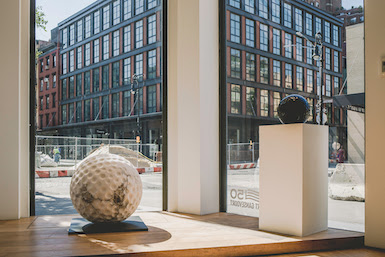[ad_1]

Installation view of Paula Crown’s show at the headquarters of For Freedoms.
EVAN WALSH/COURTESY OF FOR FREEDOMS
In the run-up to the 2016 presidential election in the United States, a billboard cropped up in Pearl, Mississippi along Interstate 80 that read, “Make America Great Again.” That was a fairly ubiquitous slogan in the state by that point, but in this instance it overlaid a famous image from the civil rights movement: activists John Lewis and Hosea Williams standing with a group of fellow activists in Selma, Albama, just before state troopers and others attacked them.
Some residents of Pearl were confused and even angered by the image, according to local media reports, and when that coverage quickly went viral, it was revealed that the piece, by Spider Martin, was part of a public-art initiative called For Freedoms, started by artists Hank Willis Thomas and Eric Gottesman.
Over the past two years, For Freedoms has grown rapidly. The organization has hosted town-hall style meetings in New York and Los Angeles, and placed 18 other billboards in 12 states, created by artists such as Carrie Mae Weems, Trevor Paglen, Alec Soth, and Zoë Buckman, all with the aim of provoking discussion on important issues facing the country.
Last week, the group opened a temporary headquarters in conjunction with New York gallery Fort Gansevoort in the Meatpacking District. It also launched a Kickstarter initiative to fund 50 billboards in all 50 states (aptly titled “50 Billboards, 50 States”)—an effort that its founders hope will amount to “the largest creative collaboration on a public art project in the history of the country,” Thomas said, speaking to ARTnews at the headquarters, where phone-banking for the cause was underway.
“We’re trying to bring these different artists’ voices more into the realm of public discourse,” he continued, “which is part of the way that advertising works—it reaches a very wide audience. So we’re trying to think about art and creativity, beyond just the confines of the art world, but out into contexts around the country on the side of the road.”
The launch of the “50 States, 50 Billboards” initiative was coupled with exhibition at the New York space by Chicago–based artist Paula Crown, titled “I am FOR.”
“With this whole For Freedoms exercise, we want to activate people to underscore that they do have a voice,” Crown told ARTnews. Among the topics her work aims to address, she said, are racist blackballing, environmentalism, and political factionalism. Of collaborating with For Freedoms, she said, “It just makes my heart sing—the idea that, here are connections, here are artists finding their mode of being, and we’re able to create such civil space to be together and really solve problems along human lines and not political lines.”
That notion of putting problem solving above politics is central to the mission of For Freedoms, which gives selected artists complete creative control over the messages in their works. Among those signed up to create billboards are Sanford Biggers, Tania Bruguera, Sam Durant, Theaster Gates, Rashid Johnson, Marilyn Minter, Richard Misrach, Dread Scott, Xaviera Simmons, and Nari Ward.
Gottesman described the organization as not just non-partisan, but “anti-partisan,” saying, “We’re really trying to decentralize how these billboards are being produced. In that situation, we’re letting go of control, which is kind of a scary process. . . . There are billboards we’ve received, and it wouldn’t be exactly the way we might do things, but they are valid voices of expression and worthy of conversation.”
For Freedoms has so far raised $120,000, enough to place billboards in 23 states. The fundraising campaign closes tomorrow, July 3, and the works will begin speckling the country on September 1, just as the midterm election is heating up.
Thomas said, “We believe that it’s important to be in as many places as we possibly can. That’s why we did it as a Kickstarter campaign, we wanted it to be both local and national. We want to be both urban and rural. . . . What we found with the MAGA billboard is that, most people have never heard of Pearl, Mississippi, but somehow it stuck out more there, and the story was even stronger because local news made it a story.”
[ad_2]
Source link

